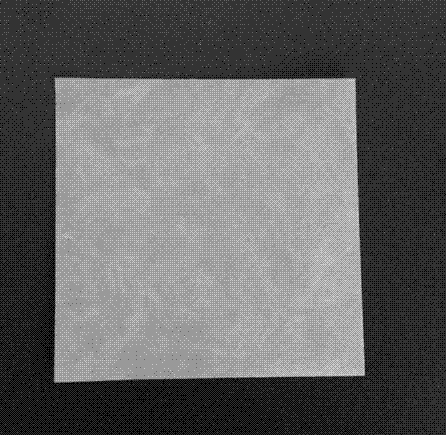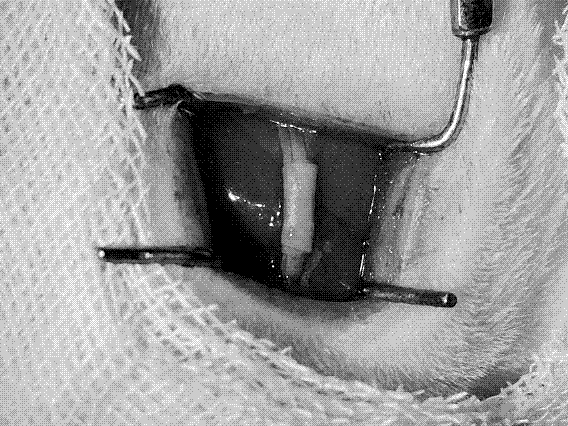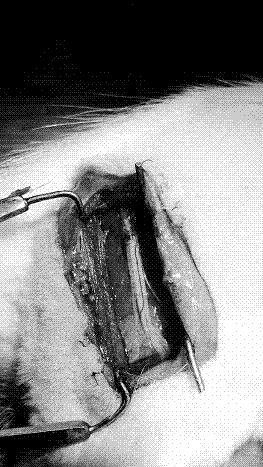Nerve repairing film and preparation method thereof
A nerve repair and animal tissue technology, applied in the field of medical biomaterials, can solve the problems of reducing the effect of nerve repair, the outflow of nerve growth factors, and hindering the growth of regenerated nerve fibers into the distal end of the nerve, so as to promote nerve regeneration and prevent adhesion.
- Summary
- Abstract
- Description
- Claims
- Application Information
AI Technical Summary
Problems solved by technology
Method used
Image
Examples
Embodiment 1
[0026] Example 1 A nerve repair membrane was prepared from pig dermis.
[0027] Take fresh pig dermis, remove excess fat, grind mechanically, rinse with deionized water for 3 times, then rinse with 0.2% trypsin solution for 2 hours, rinse with deionized water, and then rinse with 3% trypsin solution Sodium lauryl sulfate solution was shaken and rinsed for 3 hours, and rinsed with deionized water to obtain acellular porcine dermal matrix, which was freeze-dried, and the freeze-dried acellular dermal matrix was crushed with a high-speed homogenizer and dissolved in 0.5mol / L acetic acid solution, then pour it into a flat-bottomed mold, dry it at low temperature, then neutralize it with 0.1mol / L NaOH solution, wash it with deionized water until the pH is neutral, and dry it to get the nerve repair membrane (see figure 1 ), in order to prolong its degradation time, 254nm ultraviolet radiation was used to cross-link for 2h.
Embodiment 2
[0028] Example 2 The biocompatibility test of the nerve repair membrane prepared in Example 1 was carried out, including cytotoxicity test, hemolysis test and intradermal reaction test.
[0029] (1) Cytotoxic reaction test
[0030] Method: Prepare the test solution according to the ratio of nerve repair membrane with a surface area of 6cm2 plus 1mL extraction medium (MEM medium containing serum), (37±1)°C, (24±2)h, and take the test solution according to GB / T16886.5 -2003 stipulated in the test method of extract solution, and graded according to GB / T14233.2-2005.
[0031] Results: The cytotoxic reaction of nerve repair membrane was less than grade 1.
[0032] (2) Hemolysis test
[0033] Method: The test solution was prepared according to the proportion of nerve repair membrane with a surface area of 6 cm2 plus 1 mL of 0.9% sodium chloride solution, (37±1) °C, (24±2) h, and carried out according to the test method specified in GB / T16886.4-2003.
[0034] Results: The hemo...
Embodiment 3
[0038] Example 3 The nerve repair membrane prepared in Example 1 was used to repair the sciatic nerve injury of SD rats.
[0039] Establish the SD rat sciatic nerve injury model, after the test group is sutured end-to-end, the nerve repair film prepared in Example 1 is used to wrap the suture port ( figure 2 ), the control group was only sutured end-to-end. Anatomical observation was carried out 8 weeks after the operation. It can be seen that there is no tissue adhesion around the sciatic nerve of the SD rats in the test group, the nerve repair membrane has been completely degraded and absorbed, the suture is anastomosed well, and there is no neuroma formation ( image 3 ). In the SD rats in the control group, obvious tissue adhesion occurred around the sciatic nerve, and there was neuroma formation around the suture ( Figure 4 ).
PUM
| Property | Measurement | Unit |
|---|---|---|
| thickness | aaaaa | aaaaa |
Abstract
Description
Claims
Application Information
 Login to View More
Login to View More - R&D
- Intellectual Property
- Life Sciences
- Materials
- Tech Scout
- Unparalleled Data Quality
- Higher Quality Content
- 60% Fewer Hallucinations
Browse by: Latest US Patents, China's latest patents, Technical Efficacy Thesaurus, Application Domain, Technology Topic, Popular Technical Reports.
© 2025 PatSnap. All rights reserved.Legal|Privacy policy|Modern Slavery Act Transparency Statement|Sitemap|About US| Contact US: help@patsnap.com



